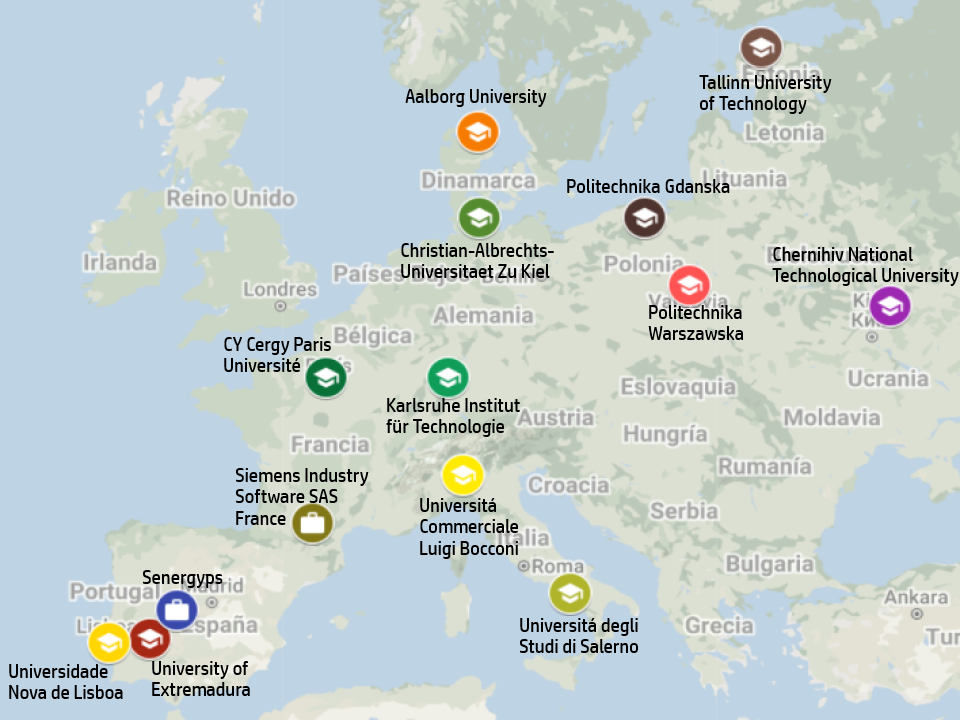Its general objetive is to drive the evolution of European Electric Energy Systems by integrating the knowledge on Power Electronics, Electric Engineering and Information and Communication Technology as well as their socio-economical aspects with the creation of new Businesses Models to cover the green economy energy requirements (sustainability, efficiency, reliability and manageability). SMARTGYsum contributes to long-term structural challenges and also proposes an innovative programme for training ESRs following a collaborative, transferable, inter and multidisciplinary approach, aimed at raising the employability and career opportunities of ESRs within the public and the private sectors, as well as their potential for conducting innovation, entrepreneurship and for impacting in the European society at medium and long-term.
Presentation
The overall objective of this ITN is to implement a multidisciplinary and innovative research and training programme, bringing together different scientific fields and industrial participation to enable a new generation of Early Stage Researchers (ESR) to foster a New Green Energy Economy in Europe. SMARTGYsum – Smart and Green Energy Systems and Business Models research and training programme will focus on providing the ESR with relevant knowledge, methods and skills across a wide range of disciplines around the Energy ecosystem and within the accelerating area of Renewable Electric Energy Systems (REES) to sustain the proliferation and consolidation of business models which will sustain the deployment of REES and technologies into the green energy system. Today, various barriers prevent an increased deployment of renewable electric energy systems including: Market and social barriers (price distortion through externalities, low priority of energy issues, split incentives, etc); Financial barriers (investment, high up-front costs, lack of access to capital etc); Information failures (lack of awareness, knowledge and competence); Regulatory barriers (restrictive procurement rules). The business models in SMARTGYsum – will be developed as strategies to invest in renewable electric energy systems in which the financing and implementation of renewable electric energy systems contribute to overcome the deployment of REES. This goal will be achieved by a unique combination of direct research training, non-academic internships and courses and seminars/workshops on scientific and complementary so-called “transversal” or “soft” skills facilitated by a multidisciplinary, multisectoral and international consortium .
Objectives
Specifically, SMARTGYsum – establishes scientific and training objectives corresponding with all the stages of Electric Energy Systems to develop the knowledge and capacities required for:
-
1.The generation and storage of electric energy using Renewable Electric Energy Generation (REEG) sources and distributed energy resources (DER), and their integration in ESS. (Addressed in WP2)
-
2.The distribution of electric energy from generator to consumers, ensuring the optimal efficiency of the system through collaborative models and radial networks. (Addressed in WP3)
-
3.The analysis of the socioeconomic elements, among them the consumption patterns and behaviours, consumer engagement and other aspects that allow to understand and promote new business models to tackle with the customer prosumption concept, as well as the market uptake of energy and ICT innovation. (Addressed in WP3, WP4 and WP5)
-
4.Coordination of all sectors of Electric Energy Systems fusing smart grids, combining IoT, sensor networks, Big Data, AI and together with societal/social and behavioural aspects. (Addressed in WP5)
-
5.To perform knowledge networks and platforms to promote the required changes in the academia, industry, policy and society. (Addressed in WP6 and WP7)
Methodology and aproach

SMARTGYsum – is organised in 7 Work Packages (WPs) corresponding to the stated objectives following the internal structure depicted in the figure. The achieve the stated research objectives, SMARTGYsum – will use a research methodology that combines engineering and business models, based on the design and computer simulation, using advanced techniques of digital twins, development using laboratories prototypes or preliminary versions of software appliances, including rapid prototyping and hardware in the loop, experimental validation in given scenarios, as closed as possible to real cases, and finally the definition and test of business models using simulation and small application cases, when possible during the secondments at non-academic sectors. This will enable the coupling of the technological requirements with the related changes needed in the socioeconomical context.
The ground-breaking nature of SMARTGYsum – lays on the integration of different technical and socioeconomical research dimensions to contribute to the transformation of the EES beyond the state of the art of green economy models and management systems. SMARTGYsum – will bring together all stages of smart grids (generation, distribution and use of energy) through the research of innovative business models that tackle the existing challenges in the evolution of EES into CSGs in each of the mentioned stages , while covering the technological developments needed to meet the requirements of the green economy.

